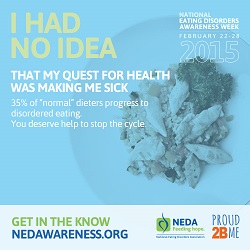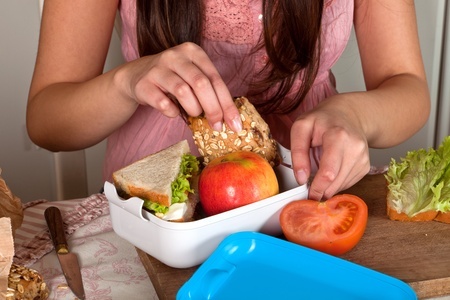 Dancers are artistic athletes. They need the strength and energy to meet the physical demands of training and performing and they also need to maintain the aesthetic requirements of their art. Figuring out the best way to eat to achieve both can be challenging. And unfortunately, the pressures of the profession, the abundance of misinformation, the influence of fellow dancers, and the lure of the magical quick-fix can lead to following a diet that is more harmful than healthy.
Dancers are artistic athletes. They need the strength and energy to meet the physical demands of training and performing and they also need to maintain the aesthetic requirements of their art. Figuring out the best way to eat to achieve both can be challenging. And unfortunately, the pressures of the profession, the abundance of misinformation, the influence of fellow dancers, and the lure of the magical quick-fix can lead to following a diet that is more harmful than healthy.
Unhealthy diets are usually overly restrictive and difficult to sustain. They can lead to decreased strength, energy, and focus, and increase your risk of injury. No dancer wants that. To avoid the pitfalls of unhealthy diets, first you have to know what to look out for. Here’s a list of the Top 5 Diet Mistakes I often see dancers make (and made myself as a dancer before I knew better!).
Top 5 Dancer Diet Mistakes
1. Following a low-carb diet.
Although carbohydrates (aka carbs) are often demonized, they are an essential nutrient – especially for dancers and other athletes. Carbs are the main source of fuel for your brain and muscles, so it’s not surprising that low-carb diets often cause fatigue and make it harder to focus.
On the other hand, eating the right amount and type of carbs will improve your energy levels and concentration, making it easier to pick up and perform difficult choreography. Getting enough carbs in your diet also ensures that protein can be used for muscle repair (this is known as the protein-sparing effect of carbs). Whole grains, high-fiber starchy vegetables, beans/legumes, and fruit are all good carb choices. If you are interested in learning more about carbs, check out this article.
2. Eating too little.
Dancers are prone to undereating. For some, long rehearsals and busy schedules make it tough to fit in enough at meals and snacks. For others, the pressure to achieve or maintain a certain weight or body composition can lead to cutting back too much on important nutrients. Regardless of the reason, under-fueling can have serious consequences for a dancer’s health and career such as muscle loss, bone loss, weakened immune system, and increased risk of injury.
3. Ignoring Meal and Snack Timing.
It’s not just what you eat, but when you eat it that’s important. Getting the right balance of nutrients at the right time can help sustain energy levels, prevent digestive problems, and aid in muscle recovery and injury prevention.
Here are some Performance Meal Timing Tips to get you started:
- Have a well-balanced meal including carbohydrates, protein, and fat about 3-4 hours before a performance.
- Have a carbohydrate-rich snack 30-60 minutes before the performance to “top off” your energy stores. A piece of fruit, handful of dried fruit, or sports drink are good choices.
- Limit fat and fiber in pre-performance meals. These nutrients slow down digestion and may cause stomach upset – especially when combined with nerves (so large salads are usually not the best pre-performance choice!).
- Have a snack that includes both carbohydrates and protein after the performance – ideally within 30 minutes of when you finish dancing. Carbs are necessary to replenish the muscle fuel you used up while dancing, and protein is needed for muscle repair and recovery. Recovery nutrition is especially important if you have two performances in the same day. Low-fat chocolate milk, a protein/fruit smoothie, or peanut butter and crackers are all good post-performance choices.
4. Following fad diets.
From cleanses to detoxes to caveman diets, fad-diets are everywhere, and their promises of quick, miracle-like results can be hard to resist. But it’s important for dancers to know that most fad diets don’t have any good scientific evidence to support their claims. For example, there’s no need to do a cleanse or detox diet – your kidneys and liver will cleanse and detox your body naturally! And these diets can have dangerous side effects such as dehydration or electrolyte imbalances.
Most fad diets involve excessive and unrealistic food restrictions that can cause nutrient deficiencies, make you susceptible to injury, and may trigger an eating disorder. Plus numerous studies have found that diets are more likely to cause weight gain than long-term weight loss. Instead of following an ineffective and potentially harmful fad diet, focus on improving your diet in small, sustainable ways that will help rather than harm your health and career.
5. Trying to eat “perfectly.”
The pursuit of perfection can help you continue growing and improving as a dancer, but it’s not a helpful approach when it comes to food. Categorizing foods, meals, or days of eating as “good” or “bad” can cause feelings of guilt, frustration, and deprivation which may lead to overeating or bingeing. Sometimes, the focus on perfect healthy eating can turn obsessive and begin interfering with quality of life (a type of disordered eating known as orthorexia). Remember that there is no such thing as perfect eating – it’s all about balance. Strive to make the healthiest choices most of the time, but leave room to include your favorite foods and treats too.
Interested in learning more? Contact us for more information on our dancer-specific services including the Eat Better Dance Better Nutrition Workshop for Dancers.
 It’s National Eating Disorders Awareness Week, and this year’s theme, “I Had No Idea,” focuses on raising awareness about the possible triggers and warning signs of eating disorders. Being able to recognize these signs, symptoms, and contributing factors makes early intervention possible and can prevent a full-blown eating disorder from developing. Early detection and intervention also increases the chances of full recovery.
It’s National Eating Disorders Awareness Week, and this year’s theme, “I Had No Idea,” focuses on raising awareness about the possible triggers and warning signs of eating disorders. Being able to recognize these signs, symptoms, and contributing factors makes early intervention possible and can prevent a full-blown eating disorder from developing. Early detection and intervention also increases the chances of full recovery. Have you ever missed lunch because you didn’t have time to run out and grab a meal? Then you know firsthand that delaying or skipping meals leaves you feeling ravenous. Being overly hungry can decrease focus and productivity and increase irritability and stress. That’s no fun for anyone!
Have you ever missed lunch because you didn’t have time to run out and grab a meal? Then you know firsthand that delaying or skipping meals leaves you feeling ravenous. Being overly hungry can decrease focus and productivity and increase irritability and stress. That’s no fun for anyone!


